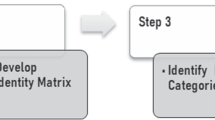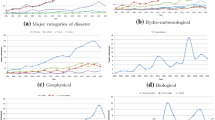Abstract
Hydro-meteorological hazards have an immense effect on this planet throughout the history of disasters from prehistoric to recent times. Despite numerous studies on hydro-meteorological hazards, however, little attention has been paid to the role of ICT in the management of these hazards. Emerging techniques of ICT (Information and Communication Technology) have encouraged the researchers to incorporate these techniques for managing hydro-meteorological hazards. Through a scientometric analysis of the bibliographic data retrieved from Scopus for 2010 to 2019 observation period, this study reveals the pattern of research on hydro-meteorological hazards and the role of various information and communication technologies in the management of these hazards worldwide. This study provides a framework for visualizing the growth of publications, role of ICT in hazards management, citation pattern, countries collaboration and most influential countries, journals and articles. The further analysis evaluates the prominent authors in each category and co-occurrence of key research areas. The results of research outputs show that remote sensing, GIS & artificial intelligence are rapidly grown technologies in the field of hydro-meteorological hazard management over the last 10 years. Since 2013 IoT, cloud computing & big data are emerging technologies in this domain. This scientometric study provides directions for future research in ICT assisted hydro-meteorological hazard management.















Similar content being viewed by others
References
Aria M (2017) Bibliometrix: an R-tool for comprehensive science mapping analysis. J Informetr 11:959–975
Binti A, Siti Nor K, Aoki Y (2017) Disaster detection from aerial imagery with convolutional neural network, International Electronics Symposium on Knowledge Creation and Intelligent Computing (IES-KCIC), IEEE, 239–245
Cobo MJ (2011) Science mapping software tools: review, analysis and cooperative study among tools. J Am Soc Inf Sci Technol 62(7):1382–1402
Habiba M, Akhter S (2013) A cloud based natural disaster management system. International Conference on Grid and Pervasive Computing, 152–161
Hanfler M, Fröhlich B, Riehmann Patrick (2006) Interactive sankey diagrams - a planning and information tool, IEEE Symposium on Information Visualization 2005. 261–272
Hussain A (2011) A citation analysis of top research papers of computer science. Int Res J Lib Inf Sci 1(2):121–132
Ivić M., Intelligence Artificial (2019) Geospatial analysis in disaster management, ISPRS - International Archives of the Photogrammetry, Remote Sensing and Spatial Information Sciences, 161–166
Jacso P (2006) Deflated inflated and phantom citation counts. Online Inf Rev 30(3):297–309
Jayawardena AW (2015) Hydro-meteorological disasters: causes, effects and mitigation measures with special reference to early warning with data driven approaches of forecasting. Procedia IUTAM 17:3–12
Kaku K (2018) Satellite remote sensing for disaster management support: A holistic and staged approach based on case studies in Sentinel Asia. Int J Disast Risk Reduct 33:417–432
Kumar RS, Kaliyaperuma K (2015) A scientometric analysis of mobile technology publications. Scientometrics 105(2):921– 939
Luo T, Maddocks A, Iceland C, Ward P, Winsemius H (2015) World’s 15 countries with the most people exposed to river floods. World Resources Institute, 5
Maynard-Ford MC, Phillips EC, Chirico PG (2008) Mapping vulnerability to disasters in Latin America and the Caribbean, 1900–2007. US Geological Survey Open-File Report 1294:30
Mcmaster R, Leitner H, Sheppard E (1997) GIS-based environmental equity and risk assessment. Cartogr Geogr Inf Sci 24(3):172–189
Meho LI, Rogers Y (2008) Citation counting, citation ranking, and h-index of human–computer interaction researchers: a comparison of scopus and web of science. J Am Soc Inf Sci Technol 59(11):1711–1726
MunichRENatCatSERVICE (2020) Available online: https://natcatservice.munichre.com/ (Accessed on 5 January 2020)
Pradhan B (2012) A comparative study on the predictive ability of the decision tree, support vector machine and neuro-fuzzy models in landslide susceptibility mapping using GIS. Comput Geosci 51:350–365
Rahman MD, Di Liping, Esraz-Ul-Zannat MD (2017) The role of big data in disaster management. In: Proceedings international conference on disaster risk mitigation, pp 23–24
Rahman MT, Rahman S, Mansoor S, Deep V, Aashkaar M (2016) Implementation of ICT and wireless sensor networks for earthquake alert and disaster management in earthquake prone areas. Procedia Comput Sci 85:92–99
Saxena NK, Murty TS (1988) Tsunami research—a review and new concepts, Natural and Man-Made Hazards, 163–170
Sinha A, Kumar P, Rana N, Islam R, Dwivedi YK (2019) Impact of internet of things (IoT) in disaster management: a task-technology fit perspective. Ann Oper Res 283:759–794
Van Eck NJ, Waltman L (2010) Software survey: VOSviewer, a computer program for bibliometric mapping. Scientometrics 84:523–538
Westen CJ (2013) Remote sensing and GIS for natural hazards assessment and disaster risk management. Treatise on Geomorphology. Remote Sensing and GIScience in Geomorphology 3:259–298
Wu H, Huang M, Tang Q, Kirschbaum DB, Ward P (2016) Hydrometeorological hazards: monitoring, forecasting, risk assessment, and socioeconomic responses. Adv Meteorol, 1–3
Author information
Authors and Affiliations
Corresponding author
Additional information
Communicated by:H. Babaie
Publisher’s note
Springer Nature remains neutral with regard to jurisdictional claims in published maps and institutional affiliations.
Rights and permissions
About this article
Cite this article
Kaur, M., Sood, S.K. Hydro-meteorological hazards and role of ICT during 2010-2019: A scientometric analysis. Earth Sci Inform 13, 1201–1223 (2020). https://doi.org/10.1007/s12145-020-00495-0
Received:
Accepted:
Published:
Issue Date:
DOI: https://doi.org/10.1007/s12145-020-00495-0




